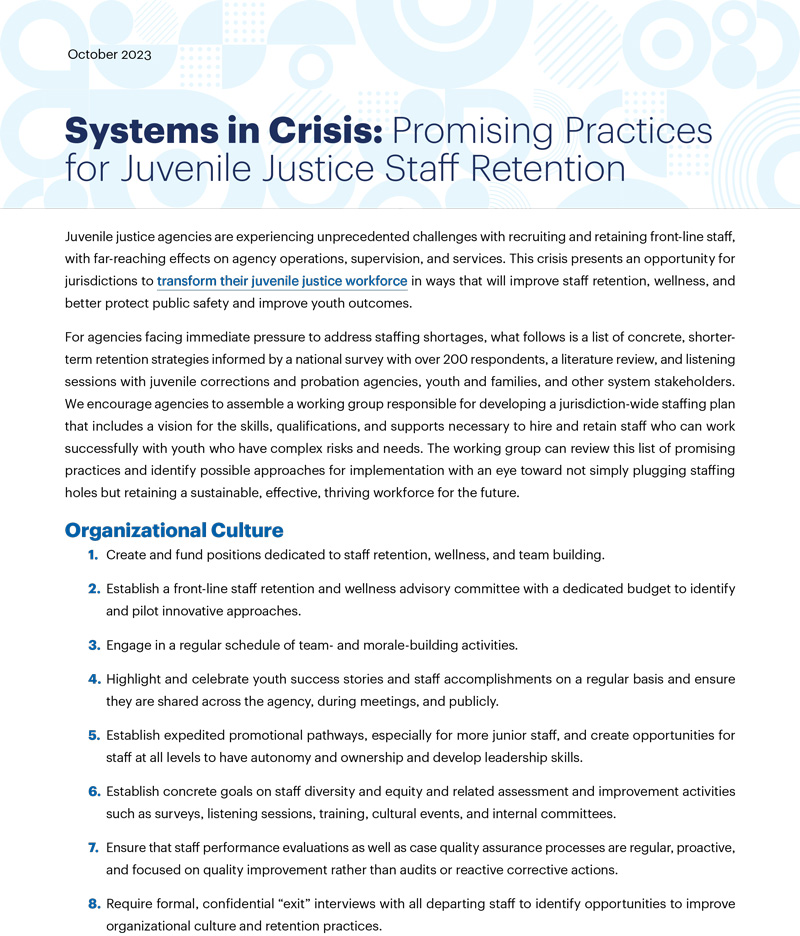
Staff Retention
Juvenile justice agencies are experiencing unprecedented challenges with recruiting and retaining front-line staff, with far-reaching effects on agency operations, supervision, and services. This crisis presents an opportunity for jurisdictions to transform their juvenile justice workforce in ways that will improve staff retention, wellness, and better protect public safety and improve youth outcomes.
For agencies facing immediate pressure to address staffing shortages, what follows is a list of concrete, shorter-term retention strategies informed by a national survey with over 200 respondents, a literature review, and listening sessions with juvenile corrections and probation agencies, youth and families, and other system stakeholders. We encourage agencies to assemble a working group responsible for developing a jurisdiction-wide staffing plan that includes a vision for the skills, qualifications, and supports necessary to hire and retain staff who can work successfully with youth who have complex risks and needs. The working group can review this list of promising practices and identify possible approaches for implementation with an eye toward not simply plugging staffing holes but retaining a sustainable, effective, thriving workforce for the future.
Organizational Culture
- Create and fund positions dedicated to staff retention, wellness, and team building.
- Establish a front-line staff retention and wellness advisory committee with a dedicated budget to identify and pilot innovative approaches.
- Engage in a regular schedule of team- and morale-building activities.
- Highlight and celebrate youth success stories and staff accomplishments on a regular basis and ensure they are shared across the agency, during meetings, and publicly.
- Establish expedited promotional pathways, especially for more junior staff, and create opportunities for staff at all levels to have autonomy and ownership and develop leadership skills.
- Establish concrete goals on staff diversity and equity and related assessment and improvement activities such as surveys, listening sessions, training, cultural events, and internal committees.
- Ensure that staff performance evaluations as well as case quality assurance processes are regular, proactive, and focused on quality improvement rather than audits or reactive corrective actions.
- Require formal, confidential “exit” interviews with all departing staff to identify opportunities to improve organizational culture and retention practices.
Training, Professional Development, and Mentoring
- Employ a full-time orientation, training, and professional development director.
- Hire, orient, and train staff in cohorts to foster relationships, and restructure orientation programs to include job shadowing, mentoring, and more robust, skills-based training.
- Provide on-the-job introductory and ongoing professional development opportunities, including
asynchronous and remote learning and participation in paid training and certification programs. - Provide ongoing professional development and training specifically in behavioral health, trauma, motivational techniques, and de-escalation.
- Develop formal shadowing and mentoring programs that match junior or new staff with senior staff as well as peer-to-peer or buddy/staff “pod” systems with regularly required activities.
- Detail clear supervisory policies, training for supervisors, and remediation outlets for front-line staff who are struggling with their supervisors to ensure that front-line staff feel well supported.
Salary Levels and Financial Incentives
- Provide annual salary increases, at minimum, matched to inflation and additional increases or bonuses for staff evaluated as performing at a high level.
- Create retention bonuses tied to key tenure milestones (such as one year, three years, five years), as well as incentives and bonuses for participating in agencywide improvement initiatives and special projects.
- Provide benefit incentives to employees such as vacation time, flex time, overtime, transportation stipends, and tuition reimbursement that scale with tenure.
Schedule and Workplace Flexibility
- Explore and offer creative shift rotations for all positions (shorter or longer shifts, daytime vs. evening, split schedules, weekdays or weekends off, etc.) and stagger schedules.
- Mandate staffing ratios and high-risk caseloads that are lower than federal requirements to make the job more manageable and offer flexibility in case of staff shortages.
- Identify components of the job that can be done remotely, such as administrative requirements and data entry, and encourage flexible work-from-home policies.
- Provide staff with employer-funded cell phones and allow them to always have them on the job for safety and convenience.
- Audit all aspects of current job duties and restrictions to identify components that are irrelevant, duplicative, or ineffective in today’s work environment, and remove as appropriate.
Wellness Supports
- Create a staff wellness committee and engage in a variety of wellness supports and initiatives for staff, and ensure that staff have the time to participate.
- Fund and hire dedicated, sufficient licensed mental and behavioral health professionals to work with youth
so that ill-equipped staff are not forced to take on these responsibilities. - Develop a strategic plan to establish trauma-informed environments, policies, and practices for youth and staff; regularly screen youth and staff for trauma; and provide and fund regularly accessible counseling and other supports.
- Establish formal restorative justice and mediation activities for when conflict between youth and staff arises.
- Conduct annual time and work studies to evaluate staff’s workload and reallocate or adjust as needed.
Performance Measures and Data Collection
- Develop performance measures and goals related to staff hiring and retention.
- Collect, analyze, and regularly report data on progress toward these goals, including analysis by staff
demographics (generation, race, gender, tenure, etc.), facility, locale, provider, etc.

This brief was prepared by The Council of State Governments Justice Center with support from the U.S. Department of Justice’s Office of Justice Programs’ Office of Juvenile Justice and Delinquency Prevention through grant number 15PJDP-21-GK-03216- JRIX. The opinions, findings, and conclusions or recommendations expressed in this publication are those of the authors and do not necessarily reflect those of the U.S. Department of Justice.

